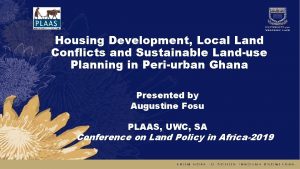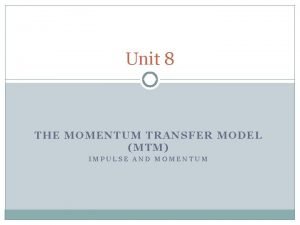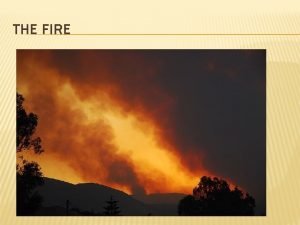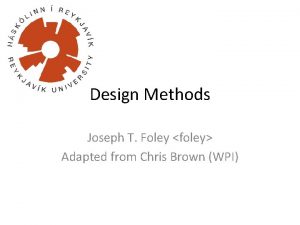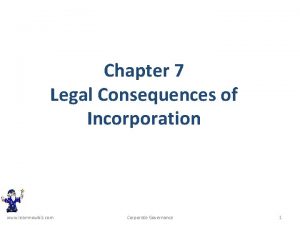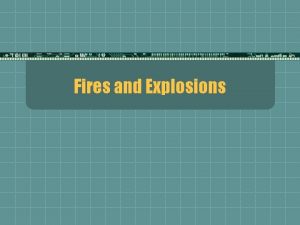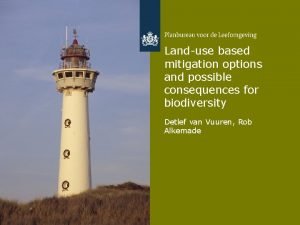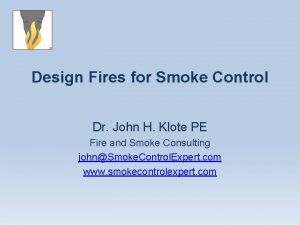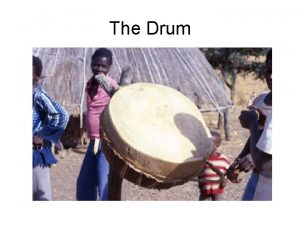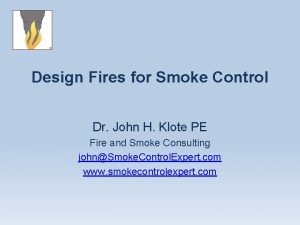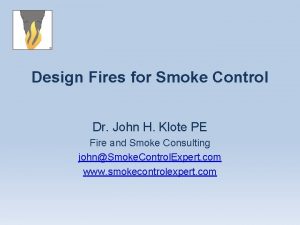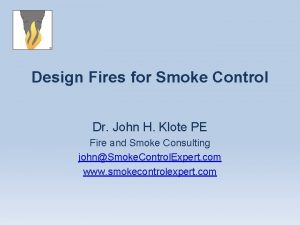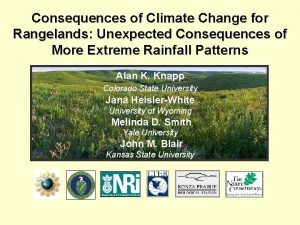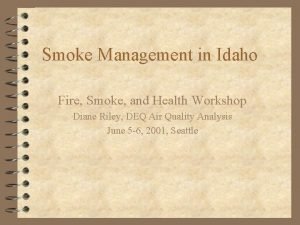Smoke from Sumatran fires consequences of landuse change




















- Slides: 20

Smoke from Sumatran fires: consequences of land-use change and anomalous meteorology for human health in Equatorial Asia Shannon Koplitz, Loretta Mickley, Daniel Jacob, Patrick Kim, Joel Schwartz, Jonathan Buonocore, Samuel Myers Harvard University Ruth De. Fries, Miriam Marlier Columbia University

Millions of people live very close to burning peatlands. Oil Palm Area in Indonesia Land use in peat swamp forests as of 2010 Logging Mature oil palm Immature oil palm Oil palm Peat Miettenen et al. , 2012 Statistik Perkebunan, Indonesia(2011); Palm Oil Industry(2013) Land use change fires in Indonesia pose a severe threat to human health in Equatorial Asia Reid et al. , 2013

El Nino and positive Indian Ocean Dipole conditions lead to more fire in Indonesia. El Nino – Southern Oscillation Normal Indonesia wet California El Nino Australian Bureau of Meteorology Both El Nino and positive IOD phases suppress convection over Indonesia, leading to drought. dry IPCC AR 5 Source: IPCC AR 5 Shannon Koplitz, Harvard University Past big haze events like 1997 and 2006 were El Ninos and positive phases of the IOD. AGU Fall Meeting 2014

“Haze in Singapore hits PSI all-time record high of 371” - Yahoo! News “Smoke Engulfs Singapore” “Singapore haze hits record high from - BBC News Indonesia fires” - NASA “Indonesian president apologizes for haze disaster” -Inside Investor “Pekanbaru’s airport shut down due to thick haze” - Antara News Shannon Koplitz, Harvard University AGU Fall Meeting 2014

June 2013 event was ENSO neutral and a negative IOD. ENSO Index El Nino cutoff June 2013 La Nina cutoff Aqua MODIS SST anomaly for June 2013 Data from www. cpc. ncep. noaa. gov C (relative to 2003 -2013) Shannon Koplitz, Harvard University Australian Bureau of Meteorology AGU Fall Meeting 2014

The Madden-Julian Oscillation can affect surface winds. The MJO has a period of 30 -90 days and is a driver of intraseasonal variability in the tropics. GEOS 800 h. Pa June 2013 Anomaly Schematic of MJO system westerlies over Sumatra (m s-1) (compared to 2005 -2010 average) www. cpc. ncep. noaa. gov Westerly wind anomalies in the lower troposphere from surface pressure cells Shannon Koplitz, Harvard University AGU Fall Meeting 2014

MJO phases during June 2013 may have promoted surface westerlies over Sumatra. MJO Phase Space June 2013 Phase 1 -3 Phase of MJO Haze event Phase 4 -6 Day in June 2013 Phase 7 -8 Koplitz et al. , in prep Data from www. bom. gov. au The western edge of the MJO (with surface westerlies) passed over Sumatra coincident with the haze in Singapore. Shannon Koplitz, Harvard University AGU Fall Meeting 2014

The fires during June 2013 were also anomalous. June 2013 Study area Gaveau et al. , 2014 Gaveau et al. emphasize the possible importance of a two-month dry spell immediately preceding the June 2013 fires in northern Riau Province. Shannon Koplitz, Harvard University AGU Fall Meeting 2014

June 2013 Sensitivity studies with GEOS-Chem indicate that Singapore pollution was more sensitive to surface westerlies than fire emissions during the June 2013 haze event. OMI Aerosol Index appears to capture Singapore event while AOD measurements do not. Observations of June 2013 event over Singapore June 2013 June 2004 Surface PM 10 OMI AI MODIS AOD AERONET AOD Koplitz et al. , in prep Shannon Koplitz, Harvard University (Some data/figures to follow were produced with the Giovanni online data system, NASA GES DISC) AGU Fall Meeting 2014

2005 -2014 timeseries of satellite data over Riau MODIS AOD averaging domain OMI AI MODIS fire counts mean + 3σ OMI AI agrees better than MODIS AOD with fire counts over averaging domain identifies same four major burning events Shannon Koplitz, Harvard University AGU Fall Meeting 2014

2005 -2014 timeseries of satellite data over Riau MODIS AOD averaging domain OMI AI Feb 2005 MODIS fire counts Oct 2006 March 2014 June 2013 OMI AI agrees better than MODIS AOD with fire counts over averaging domain identifies same four major burning events Shannon Koplitz, Harvard University AGU Fall Meeting 2014

Conclusions 1. Negative IOD conditions combined with the timing of the MJO may have caused the anomalous surface westerlies that carried smoke to Singapore during June 2013. Observations of June 2013 event over Singapore 2. June 2013 represents a newly discovered meteorological pathway through which land use change fires in Indonesia affect regional human health. Surface PM 10 OMI AI MODIS AOD AERONET AOD 3. OMI AI appears to successfully capture haze events over Indonesia and could be an early-warning indicator for air quality in Equatorial Asia. Shannon Koplitz, Harvard University AGU Fall Meeting 2014

Extra slides Shannon Koplitz, Harvard University AGU Fall Meeting 2014

Normalized Anomaly Investigating possible interference of dust in AOD calculations for June 2013. OMI AI MODIS AOD OMI AI appears to capture the progression of a dust plume across the Indian Ocean Basin during June 2013, while MODIS AOD does not. The presence of dust where only smoke aerosol is expected could result in underestimated AOD (Chen et al. , 2008; Johnson et al. , 2009). Shannon Koplitz, Harvard University AGU Fall Meeting 2014

MODIS doesn’t see the same four big haze events OMI AI over Riau Feb 2005 Oct 2006 June 2013 Mar 2014 MODIS AOD over Riau Shannon Koplitz, Harvard University AGU Fall Meeting 2014

Other Riau burning episodes stand out in OMI AI record OMI Aerosol Index over Riau Mar 2014 Feb 2005 Oct 2006 June 2013 mean+3σ 2005 -2014 mean Shannon Koplitz, Harvard University AGU Fall Meeting 2014

Sensitivity studies Shannon Koplitz, Harvard University AGU Fall Meeting 2014

OMI AI captured June 2013 plume over Riau, MODIS AOD did not OMI Aerosol Index over Riau June 2013 mean+3σ 2005 -2014 mean Day Haze event MODIS AOD over Riau June 2013 Day Shannon Koplitz, Harvard University AGU Fall Meeting 2014

Shannon Koplitz, Harvard University June more times than mea Koplitz et al. , in GEOS-Chem June 2013 Dust vs. Climatological Mean Dust anomaly in June 2013 AGU Fall Meeting 2014

Investigating possible interference of dust in AOD calculations for June 2013. Hovmoller of OMI AI during June 2013 (at 1° N) dust smoke June 25 June 21 June 17 June 13 June 9 June 5 June 1 AOD retrievals are sensitive to underlying assumptions about the aerosol types present. The presence of dust where only smoke aerosol is expected could result in underestimated AOD (Chen et al. , 2008; Johnson et al. , 2009). Shannon Koplitz, Harvard University AGU Fall Meeting 2014
 Sustainable landuse
Sustainable landuse Vragen
Vragen When fighting fires a firefighter must use great caution
When fighting fires a firefighter must use great caution Anatomy of a fire extinguisher
Anatomy of a fire extinguisher Stars hide your fires technique
Stars hide your fires technique Class b fires include
Class b fires include 2007 greek forest fires
2007 greek forest fires A destroyer simultaneously fires two shells
A destroyer simultaneously fires two shells Fire extinguisher pictographs
Fire extinguisher pictographs Biggest forest in europe
Biggest forest in europe Most welding environment fires occur during
Most welding environment fires occur during Fire safety objectives
Fire safety objectives Decide process
Decide process Unintended consequences
Unintended consequences Base catalyzed enolization
Base catalyzed enolization Learnnowbiz
Learnnowbiz Consequences of inflation
Consequences of inflation What is the relationship between choices and consequences
What is the relationship between choices and consequences Cause and effect examples
Cause and effect examples Consequences of horseplay
Consequences of horseplay Consequences of variation
Consequences of variation
